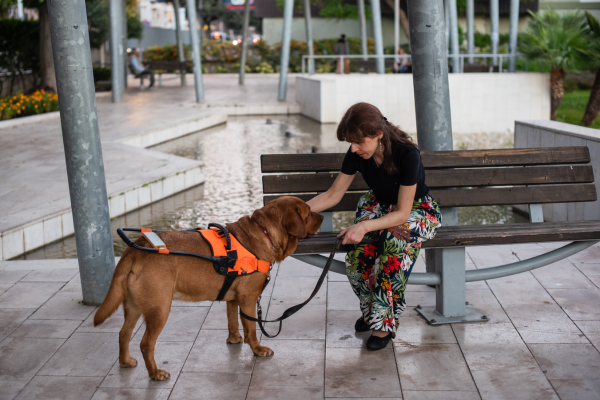Service dogs assist people with all kinds of disabilities. It may help people with vision and hearing impairments, mobility issues, certain mental health conditions, and seizures. Service dogs improve handlers’ quality of life and allow them to live more independently.
The service dog acquisition process can be complex. You must work with healthcare professionals to determine eligibility, find a service dog provider, apply for ownership, ensure your dog is trained, and cover necessary costs. With the proper guidance, you will soon have your service dog.
This article will explain how to get a service dog so you know what’s involved.
Determining Eligibility
The first steps to getting a service dog involve determining eligibility. Several disabilities qualify you for service dog ownership. They include:
- Vision impairments
- Hearing impairments
- Paralysis
- Arthritis
- Seizures
- Osteoporosis
- Scoliosis
- Asthma
- Allergies
- Autism
- Multiple sclerosis
- PTSD
Most states require you to see a healthcare professional who will provide written consent that you are service dog-eligible. However, a positive diagnosis does not make you automatically eligible. The provider will assess your individual needs to determine your eligibility.
Once you receive written consent, you may begin looking for a service dog.
Finding a Service Dog Provider
After you confirm your eligibility, you must find a service dog provider. Several organizations train service dogs and get them ready for adoption. Some nonprofit organizations provide low-cost or free service dog training and ownership.
You can also hire a private trainer. Private trainers are typically more expensive than organizations, but they can customize training to suit your needs.
The organization or trainer you choose should be accredited. They should be licensed and authorized to train service animals.
You may also choose to self-train your service dog. There are online classes that will instruct you in service dog training. However, you must ensure your dog is thoroughly trained.
Self-training also means you may miss out on the comprehensive services of a professional trainer. Trainers will help you with training and the acquisition process. They will also continue communicating with you to ensure you and your service dog have a seamless transition.
How To Get Your Dog Registered as a Service Dog
Are you wondering how to get service dog certification?
You don’t need to register or certify your dog as a service dog. However, some handlers like registering their dogs because it can help them deal with uncomfortable situations. For example, if a store owner tells a handler they can’t have a dog in their building, they can show the registration to prove their dog is a service dog and legally allowed in stores.
Several organizations allow you to register your service dog. Do an online search to find the best option and apply to have your dog registered. Typically, you will be asked to answer some simple questions to attain your registration.
The Application Process
If you look online, you will find several organizations that provide service dogs to handlers. Each organization has a different process for obtaining a service dog.
The first step typically involves filling out an online form. You may need to enter your contact information and provide some background on your medical condition.
Next, the organization may ask you to take a medical evaluation and submit the paperwork. If you have had a recent checkup, that documentation may suffice.
They may also conduct a lifestyle assessment. This may include visiting your home to observe your lifestyle or asking for more information to better assess your needs. They must determine that you are active enough to require a service dog.
This process will confirm your eligibility and help them find the dog best for your condition.
Costs and Funding
Service dogs are costly. A fully trained service dog can cost between $15,000 and $30,000. If you choose to have your dog trained, costs are comparable, ranging from $10,000 to $50,000, depending on the condition you train your dog to handle.
You will also spend about $500 annually on dog food and veterinary costs.
Handlers may decide to insure their service dogs to protect their assets. Regular dog insurance will cover service dogs and ranges from $16 to $75 per month. However, these policies won’t fully cover your dog.
You may consider add-ons like service dog life insurance and auto insurance with dog injury protection to ensure your dog is protected in various scenarios,
Grants and Financial Assistance
Fortunately, grants and financial assistance are available to people seeking service dogs. Here are some options:
- NEADS: This organization provides free service dogs to people who raise $8000 with NEADS’ assistance.
- Patriot Paws: Patriot Paws connects veterans with free service dogs.
- Assistance Dog United: This organization provides vouchers worth up to $5000 to help people pay for service dogs.
- Canine Companions for Independence: Provides free service dogs to disabled individuals and veterans with PTSD.
- United States Department of Veterans Affairs: Provides service dog benefits and connects veterans with accredited service dog organizations.
People with service dogs may also be eligible for government allowances, which vary from state to state.
Training and Matching
- Length of training process: The length of training varies according to the dog’s age, the training requirements, and how much time the handler is willing to devote to training at home. However, it typically takes one to two years.
- Matching dog to handler: The organization you adopt your service dog from will assess your lifestyle to match you with the best dog for your needs. Beyond your disability, they will also consider if you live with children. If so, they will match you with a child-friendly dog. They will also consider if you live in an urban or rural community. City dwellers will require dogs that aren’t bothered by crowds and loud noises.
- Handler training requirements: Handlers may also train dogs beyond disability assistance. For example, they may house-train their dog and teach them to socialize, focus, and ignore distractions. The dog should be trained to obey their handler at all times.
Legal Rights and Responsibilities
After you get settled with your service dog, you should get familiar with your legal rights and responsibilities. Here are some to consider.
- Americans with Disabilities Act (ADA) provisions: ADA provisions prohibit discrimination against people with disabilities in various areas such as employment, transportation, public accommodations, communications, and access to government programs. It requires that people with service dogs be allowed to go to most places open to the public. However, the handler is responsible for keeping the dog harnessed or leashed and ensuring they behave correctly.
- Public access rights: Public rights access means people with service dogs are allowed in most places that serve the public, including grocery stores, offices, beaches, parks, farmers markets, movie theaters, taxis, rideshares, and public transportation.
- Housing and employment accommodations: Most states allow handlers to bring their dogs to work with them. They may also be allowed to live in buildings that do not accept pets. However, some properties may require you to pay a pet deposit.
Ongoing Care and Common Challenges
Service dogs have ongoing needs. Here are some to be aware of.
- Adjusting to life with a service dog: Owners should welcome service dogs in a calm environment and take time to bond with them. If the handler does not live alone, they may need to instruct others not to distract the dog by petting or feeding it when working.
- Continued training: Service dogs require ongoing training to stay sharp as they age. The trainer you adopted them from should offer tips that outline how to conduct ongoing training. You may also enroll them in occasional professional training programs.
- Healthcare: Service dogs’ healthcare needs are similar to those of other dogs. They should be taken for regular vet visits, fed healthy food, and given enough physical activity.
- Public education and awareness: Handlers may find it challenging to educate people about how to treat an on-duty service dog. They may also deal with business owners who don’t understand service dog access rights. These incidents can be frustrating, but handlers must determine how to deal with them. Carrying educational materials, explaining ADA laws, or taking a passive route are all options for handlers. They may also partner with organizations or take to social media to promote awareness on a higher level.
Conclusion
So, how do you get a service dog? You must get a physical exam to establish eligibility, find a service dog provider, and go through the application process. You may also choose to train your dog yourself. Service dogs can be expensive, but financial assistance is available to those who qualify.
It may be a struggle to get used to life with a service dog, especially considering how often you encounter people who don’t understand how to treat these dogs and are unfamiliar with service owner rights. Justice Speaks is making a difference. We raise awareness by teaching school-aged students how to act around a service dog and ensuring workplace compliance. We can also help you learn what to do if your dog handler rights are not respected.
Contact us to learn more about living with a service dog and to keep your rights protected.


